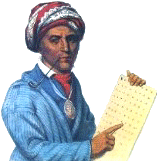

Sequoyah (ᏍᏏᏉᏯ Ssiquoya,
as he signed his name,[2][3] or ᏎᏉᏯ Se-quo-ya, as his name is often
spelled today in Cherokee) (c. 1770–1840), named in English George Gist
or George Guess, was a Cherokee silversmith. In 1821 he completed his
independent creation of a Cherokee syllabary, making reading and
writing in Cherokee possible. This was the only time in recorded
history that a member of a non-literate people independently created an
effective writing system. After seeing its worth, the people of the
Cherokee Nation rapidly began to use his syllabary and officially
adopted it in 1825. Their literacy rate quickly surpassed that of
surrounding European-American settlers.
is credited with the invention of the Cherokee written language, the so-called talking leaves. As a young man he was a fine hunter, warrior, trader, and silver craftsman. An able linguist who learned French, Spanish, and English, he was determined to preserve Cherokee culture and was implacably opposed to American intrusions into his tribal lands. After continued white encroachments, however, Sequoya journeyed westward (1797), although he returned periodically to his homeland.
Recognizing the power of the written word, Sequoya developed a Cherokee syllabary of 86 symbols by adapting letters of the English alphabet to represent sounds in the Cherokee tongue. The generally accepted date for its completion is 1821, although Cherokee tradition dates the syllabary earlier. Although there is some question whether Sequoya was its inventor, he certainly popularized the syllabary, which led to the founding of the Cherokee Phoenix, a Cherokee language newspaper, on Feb. 21, 1828.
Sequoyah's
heroic status has led to several competing accounts of his life that
are speculative, contradictory, or fabricated. As noted by John B.
Davis, there were very few primary documents describing facts of
Sequoyah's life. Some anecdotes were passed down orally, but these
often conflict or are vague about times and places.
James Mooney, a prominent anthropologist and historian of the Cherokee
people, quoted a cousin as saying that as a little boy, Sequoyah spent
his early years with his mother in the village of Tuskegee. Estimates
of his birth year ranged from 1760 to 1776. His name is believed to
come from the Cherokee word siqua meaning 'hog'. However, Davis says
the name may have been derived from sikwa (either a hog or an opposum
and vi meaning a place or an enclosure. This is a reference either to a
childhood deformity or to a later injury that left Sequoyah disabled.
His mother, Wut-teh, was known to be Cherokee, belonging to the Red
Paint Clan. Mooney stated that she was the niece of a Cherokee chief.
McKinney and Hall noted that she was a niece of chiefs who have been
identified as the brothers Old Tassel and Doublehead. Since John Watts
(also known as Young Tassel) was a nephew of the two chiefs, it is
likely that Wut-teh and John Watts were siblings.
Sources differ as to the identity of Sequoyah's father. Davis cites
Emmet Starr's book, Early History of the Cherokees, as the source for
saying that Sequoyah's father was a peddler from Swabia named Guyst,
Guist, or Gist. According to Goodpasture, some believe the father was
an unlicensed German peddler named George Gist, who came into the
Cherokee Nation in 1768, where he married and fathered a child. Grant
Foreman identified him as Nathaniel Gist, son of a Christopher Gist,
who later became a commissioned officer with the Continental Army
associated with George Washington. Mooney and others suggested that he
was possibly a fur trader, who would have been a man of some social
status and financial backing. Josiah C. Nott claimed he was the "son of
a Scotchman". An article in the Cherokee Phoenix, published in 1828,
stated that Sequoyah's father was a half-blood and his grandfather a
white man.
Cherokee (Tsalagi) Language Syllabary
25KB
Character
Names
----------------
| e ge he le me ne que se de te tle ye o go ho lo mo no quo so do |
tlo tso wo a ga ha la ma na qua sa da yo yu yv wa ya ka hna ta i |
gi hi li mi ni qui si di ti tli tsi wi yi u gu hu lu mu nu quu su |
du tlu tsu wu v gv hv lv nv quv sv dv tlv tla nah s dla tsa tsv wv tse we |
Sequoya,
or George Guess, born. ca.1760,
died Aug. 1843, buried in Zaragoza,
Coahuila, Mexico.
Sequoyah, Sequoya, Sequoia, Sikwayi

Inventor of the Cherokee Syllabary
![]() Return to
Indigenous Peoples' Literature
Return to
Indigenous Peoples' Literature
Compiled by: Glenn Welker
Copyright © 1993-2013
This page last updated 12/09/2013 23:56:24
This site has been accessed over 10,000,000 times since February 8,
1996.